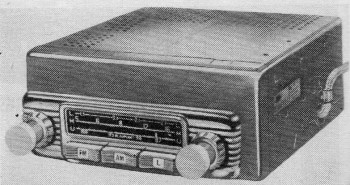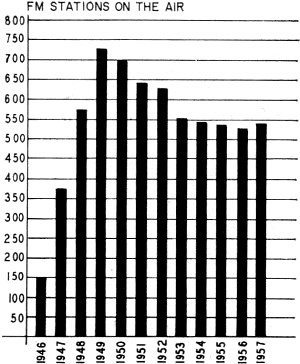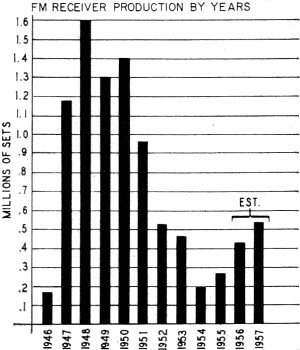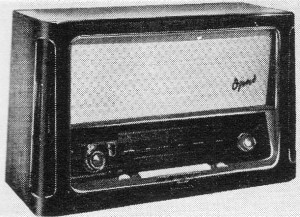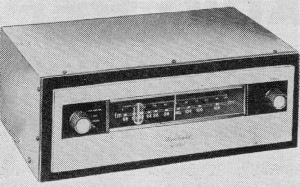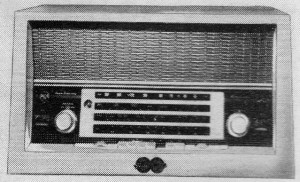Rediscovery of FM Broadcasting |
||||
"Rediscovery of FM Broadcasting" could be a contemporary headline. The decline of broadcast radio has been a major concern of station owners for well over a decade since Internet and satellite radio has dominated the venue through which listeners access radio stations. Local broadcasters have long aired syndicated programs that include national advertising, but the money to pay for those segments came from revenue supplied largely by local companies. FM broadcasting began commercially around 1945 in the familiar 88-108 MHz band yielded by the military following World War II, and grew in number of stations very rapidly in the first few years. Then, it began a decline for a few more years until finally leveling off after about a decade. Even though FM had a clear advantage (literally) over AM because of electrical noise immunity (car alternators, household appliances, lightning, arcing power lines on wet days), and its license to broadcast at night, is seems the public was not overly willing to shell out money for new radios when their old radios sufficed. The broadcast radio industry sprang into action in educating the public as to the advantages of FM, including none of the aforementioned AM weaknesses as well as superior music quality and stereo channel separation. It worked smashingly well (...a little British lingo). Today, broadcast radio (and television for that matter) is again fighting to survive in the presence of cable, satellite, Wi-Fi, Internet, and other alternative means. Ultimately, it comes down to who can attract enough advertisers to pay the bills. This is an example of is Capitalism at its finest. See also Mr. Lachenbruch's 1960 article entitled, "FM Radio Finally Makes It." Rediscovery of FM Broadcasting
Once almost down and out, FM is on the upswing again This year, for the first time since the very early 1950's, you'll see FM radios displayed by nearly all major manufacturers - and a greater assortment of imported and minor-brand FM sets than ever before. This spring or summer, you're likely to see the first AM-FM automobile radios bearing the imprint of top U. S. car radio manufacturers. Is it for real this time? Is FM going to catch on after 10 disappointing years? It's still too early to tell. But this much is apparent - FM is experiencing a very definite boost in popularity which seems sure to accelerate in 1958. It's a small increase, but it shows up at both the broadcasting and the receiving ends of the business. The downward trend in number of stations on the air and in production of receiving sets has halted for the first time since early 1950. If the signs of FM's health were plotted on a graph, 1956-57 would show up as the beginning of a small upward bump (see Fig. 1). The new signs of FM life bear close watching by everyone whose livelihood - or interest - is geared to radio.
A Sick Industry Ask almost any broadcaster and he'll tell you that FM is still a very sick industry, a far cry from the virile newcomer who seemed destined to knock AM radio out of the spectrum after World War II - until television came along. The number of FM stations on the air began tapering from its peak of 730 late in 1949, dwindling to 536 by early 1956. Then the casualties virtually stopped, and the number of operating stations even increased slightly to 544 by September, 1957. Then, last summer, the FCC's normally quiet FM section was stunned by a comparative avalanche of applications for new stations. During a single 8-week period, the commission received a total of 24 applications - an average of 3 a week, compared with fewer than one a week in the same period the preceding year. Applications on file for new stations now total about 50. For the first time in years, the FCC has more applications than available channels in some big cities - making it necessary to hold hearings among applicants for contested frequencies. In the New York City area, where 16 FM stations are operating or authorized, there are 6 applications for the 2 vacant channels. In Los Angeles, where 17 are on the air with 1 more ready to start, 5 applicants are vying for 2 remaining channels. In Philadelphia, 7 are operating and there are 4 applicants for the 4 available assignments. These cases are exceptions, of course. In most locations - even big cities like Chicago - FM channels are going begging. But these illustrations are indications of the broadcaster's current reappraisal of FM's possibilities.
Independent Programming There were other signs of a renewed interest in FM in 1957. Westinghouse Broadcasting Co. ended the repeater status of its FM outlets in Pittsburgh. Pa., and Portland, Ore., programming them separately from their AM companions - with classical music exclusively. Westinghouse also applied for a new FM station in Boston to replace the one it took off the air 2 years ago, and ordered brand-new transmitting equipment for its Cleveland FM outlet. Both of these will also be independently programmed with serious music. A few other large-network-affiliated outlets began programming their FM stations independently from AM - Washington's WMAL is an example. And NBC applied for a new FM station in Philadelphia as a companion for its AM and TV stations there, but currently has no plans for separate FM programs. Many FM-only stations, and independently programmed FM's, report a definite increase in the amount of mail received from listeners - generally considered a reliable indication of a pickup in audience size. During the long years of FM's post-1949 famine, one question frequently asked in the broadcasting industry has been: If FM is dead, why won't it lie down? Why did considerably more than half of the peak 730 stations stay on the air, when official FCC figures show only a handful of them making a profit from FM operations? The National Association of Radio & Television Broadcasters, in a recent questionnaire to FM broadcasters. asked each one to give its own reason. The most recurrent answers were: 1. By duplicating AM programs on the FM transmitter, it costs virtually nothing to stay on the air. 2. FM listeners are a loyal bunch and it would be poor public relations to turn the station off. 3. FM gives daytime-only AM stations an opportunity to provide some nighttime coverage. 4. Duplicating programs on FM extends the coverage of low-powered AM stations. 5. Local sports events, carried on FM only, have a big following. 6. The possibility of future developments in the FM band makes it worth while to keep a foot in the door. It's impossible to estimate just how many FM dials are actually being twisted. About 8,000,000 sets have been produced since FM started up after the war, but how many have been scrapped or are standing idle, nobody knows. There aren't even any current statistics on FM receiver production or sales. The industry's record keeper, Electronic Industries Association (formerly RETMA), stopped keeping track several years ago when manufacturers' interest in FM approached the vanishing point. Before EIA (or RETMA as it was then) stopped counting, it estimated 1,175,000 sets were produced in 1947, peaking to a high point of 1,600,000 in 1948 (see Fig. 2). Then came the drop, with annual output dipping to a little over half a million by 1952. In subsequent years, production probably fell to about 200,000 annually, reaching this lowest ebb in 1954. A turning point came in 1955. That year, it's estimated that production of sets and tuners increased to 275,000. The uptrend continued in 1956, with sales climbing well over 400,000, and an educated guess would put 1957 sales somewhere above half a million. Not a boom by any means - but a step up. Hi-Fi and FM What did it? All of the probable answers revolve around high fidelity and the education of the American ear. Though audio aficionados had been hooking up components for best possible musical reproduction for years, their purchases of FM tuners (made by nearly 20 small manufacturers) never comprised a numerically important factor for nationwide FM. But their enthusiasm was so contagious that by 1955 it had spread to some important manufacturers, who decided that hi fi might become a magic word for the mass market.
The time was ripe. Phonograph records had attained a quality far beyond the ability of the average phonograph to reproduce. The natural companion to hi-fi recordings was hi-fi radio-FM. But in 1956, the first big year for packaged hi fi, most of the 500,000 units sold under the hi-fi label did not contain FM. The number doubled in 1956 and a greater proportion of them had FM tuners. In 1957, it's estimated that some 1,700,000 packaged hi-fi units were sold. It's improbable that anywhere near half of them had FM, but the proportion increased again. Distributors in some cities now report that it's practically imposible to sell packaged hi-fi unit without FM. At least some of the credit for America's recently renewed interest in FM is due the Germans. In Germany, where FM has virtually replaced AM because of the crowded broadcast band, manufacturers with such jaw-breaking names as Grundig, Telefunken and Blaupunkt began exporting their generally excellent FM-AM-SW sets to the U. S. The Germans are believed to have sold as many as 50,000 here in 1956 and perhaps 75,000 in 1957. American manufacturers sat up and took notice. More American Sets During the long FM famine, only one major U. S. manufacturer - Zenith - continually produced FM receivers in quantity. Late in 1954, just before the FM upturn began, a small American manufacturer - Granco Products, Inc. - experimentally turned out a $30 FM-only set with a circuit based on the design of its uhf TV converter. This clicked, and Granco claims its sales of FM sets and tuners hit 100,000 in 1956, and even more in 1957. Other American manufacturers have decided to try again. For their 1958 lines they have announced not only hi-fi sets which include FM tuners, but such items as FM-AM clock radios and table models. Among those now offering or preparing to offer FM sets are: Motorola (its first since 1952), Admiral (first since 1954), RCA (which will import a specially made set from Germany), GE, Philco, Arvin, Columbia, Magnavox, Stromberg-Carlson and Olympic. British radio manufacturers are also hoping to crack the 1958 U. S. markets with their FM sets. At least one Japanese manufacturer plans to export FM tuners to this country. Also from Germany, along with German-made automobiles, came FM auto radios. Again, U. S. manufacturers plan to follow suit. It's understood that both Motorola and Philco have FM car radios on the drawing boards for introduction this spring or summer. Last summer, the FCC asked for the TV industry's comments on a proposal to facilitate highway FM reception with standard buggy-whip auto antennas by permitting FM stations to use vertical polarization in place of the traditional horizontal polarization. Commenting on this proposal, some FM stations pointed out that the FCC rules already permit circular or elliptical polarization which could produce the same effect without any changes in the rules. (However, no station is currently using circular or elliptical polarization). Other stations expressed the view that present transmissions can be picked up satisfactorily by conventional auto radio antennas, that if there is any reception problem at all, it will be in areas far distant from FM stations. All of these signs point to a definite increase in public awareness of FM. But FM station operators have their eyes on another development which they hope will permit them to keep serving a small and loyal public audience, and make money too. This is multiplexing (see "Multiplexing and You," Radio-Electronics, October, 1957) - now permitted by the FCC on a regular basis. The commission has more than 50 applications by existing FM stations who want to begin this service, and a number of them have already started. Stations plan many ingenious uses for the multiplexing technique. Among them are background music for stores, factories and offices; specialized programs beamed to schools; special home-study courses, etc.- all to be offered simultaneously with, and in addition to, regular FM broadcasts. Equipment has already been developed for binaural radio using a single FM channel. Some day soon, multiplex FM receivers may well be a companion to binaural tape players in the home. Which way FM? The signs of renewed activity in the 8-108-mc band are not of boom proportions. But there is more hope today than at any time since 1949 that this superior form of radio finally will take its well deserved place under the audio sun.
Posted May 14, 2019 |
||||

 By David Lachenbruch
By David Lachenbruch